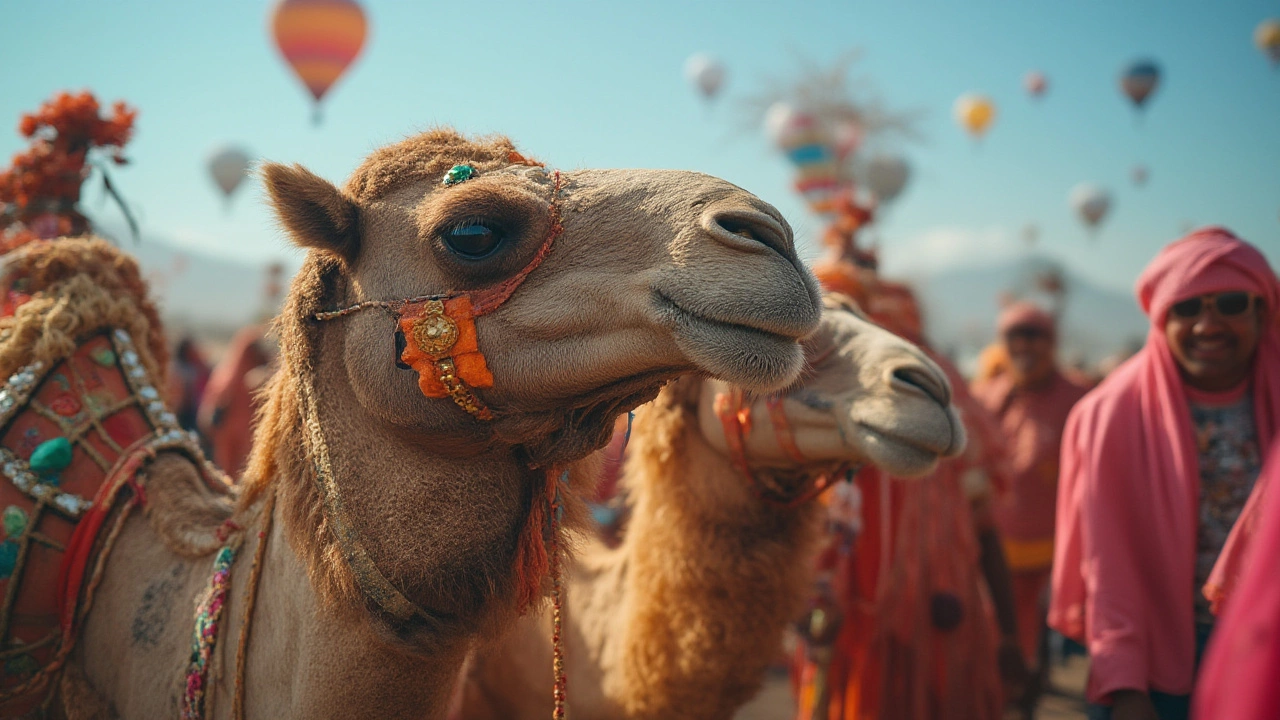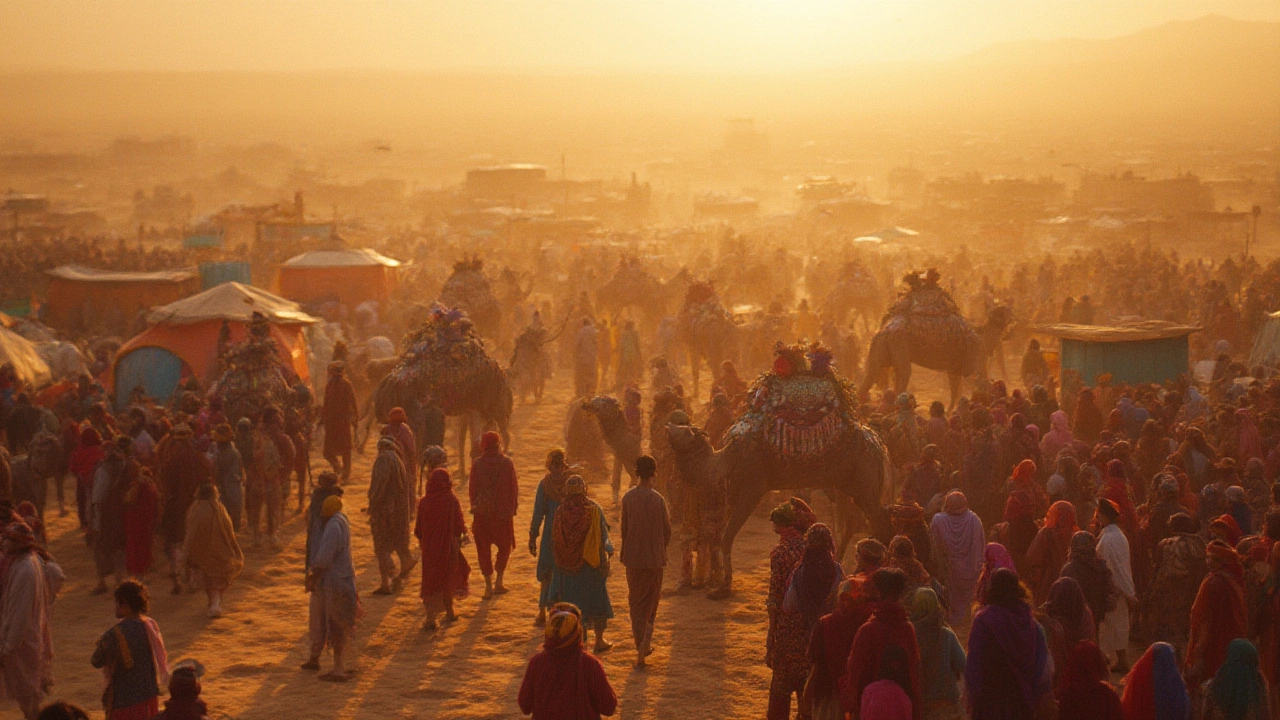Forget what you know about festivals if you haven’t seen the Pushkar Camel Fair. Imagine a swirl of smells—dust, incense, spiced chai—mixed with the sound of bargaining, music, and bleating camels. In a land with more than 30 major festivals every year, nobody blends faith and spectacle like Rajasthan’s little town Pushkar. Every November, something wild happens in the desert. You’ll see not just thousands of camels, but also moustache contests, turban-tying races, and folk musicians jamming under a starlit sky. There's no event quite like this on the planet, and the fact that every year a quarter of a million people show up is proof—locals, traders, distant nomads, and bewildered travelers. Each comes for a different reason, but all leave with the same wide-eyed story: Pushkar is magic.
A Desert Carnival: All About the Pushkar Camel Fair
If you land in Pushkar during the fair, the town looks and sounds like another world. There are camels as far as the eye can see—over 30,000 at its peak, each dressed up in beads, bells, and painted patterns. Herds roll in from miles away. Local traders haggle in Marwari, and prize animals are paraded in a bid to fetch the highest price. You’ll catch the dust swirling as animals prance around arena rings, showing off impressive humps and teeth (seriously, there’s even a camel beauty contest).
The Pushkar Camel Fair is much more than an animal market. It’s tied to the sacred Hindu month of Kartik, wrapping around a holy full moon. This is when pilgrims take a dip in Pushkar Lake, believing the waters purify them of past sins. The timing blends spiritual rituals with showmanship, a weirdly perfect mix that keeps the fair whirring day and night.
What sets it apart from other festivals in India is the sheer pageantry. Camels aren’t the only stars. There are competitions for the largest turban, the grandest moustache (seriously, moustache champions train all year), and even human pyramid-building. Women drape in freshest saris, and men go all out with cholies and dhotis. Musicians, dancers, snake charmers—all keep the crowd moving. Organizers host cricket matches, puppet shows, and dazzling evening fireworks that paint the desert in colors people remember forever.
If you’re thinking this sounds touristy, you’re only half right. Many foreigners visit, drawn by Instagram feeds and travel channel documentaries. But for locals, the fair remains about faith, family, tradition—and a good bargain for a sturdy camel or horse. And unlike set-piece events elsewhere, Pushkar is unpredictable. Every year there are new twists, surprises, and wild stories as the desert comes alive.
Origins, Rituals, and Quirky Traditions
The roots of the Pushkar Camel Fair go deep, about 150 years at least, though local historians swear it’s older. The fair centers around the Brahma Temple, one of the few places in India where the creator god is worshipped. Legend says Lord Brahma dropped a lotus here, magically forming the Pushkar Lake. Pilgrims believe that bathing in its waters during Kartik cleanses their soul—so thousands gather at sunrise for a dip, singing hymns as the sun glows orange on the horizon.
The camel trading, while now a big show, began as a simple way for desert folk to trade livestock, meet future in-laws, buy tools, and celebrate in a tough land. This practical side survives, but the rituals have grown. You’ll see priests leading elaborate arti on the ghats, creating rivers of marigold petals and flickering lamps. Families perform puja ceremonies for good fortune. And on the fairground, there’s a whole secondary world—wrestlers locking arms in akharas, horse riders racing flat out, chefs frying up spicy kachoris on open fires.
Pushkar’s offbeat contests leave visitors scratching their heads or grinning in delight. Tourists and locals try their luck at turban tying—a serious business where some fabrics stretch 8 meters long. The moustache contest might be the best known, with competitors sporting elaborate styles. The current record-holder’s moustache measures over 4 feet across! And if you’ve ever wondered about camel dancing—yes, camels dance here, encouraged by trainers with flutes and colorful tassels. It’s equal parts elegant and absurd.
Bazaars spring up all over town. You’ll find everything from hand-printed Rajasthani skirts to sparkling bangles, puppets, and herbal powders. The night markets have their own charm, full of food stalls offering malpua, dal baati churma, ker sangri, and sweets sticky enough to stay in your memory for months. There's even a henna tattoo contest and a magician’s corner for anyone willing to believe in a little desert magic.

Fascinating Facts, Stats, and Visitor Tips
Dig into the numbers and stories, and the Pushkar Camel Fair just gets wilder. For starters, Pushkar’s normal population hovers around 21,000, but during the peak of the festival, over 250,000 people flood the area. That’s twelve times more than usual, meaning every guesthouse, tent, and rooftop suddenly becomes a temporary home. On camel count alone, it’s the world’s largest gathering—no other festival brings together 30,000 camels, 10,000 horses, and thousands of cattle in one place.
Here’s a quick hit of stats:
| Pushkar Camel Fair Stat | Number |
|---|---|
| Camels | 30,000+ |
| Horses | 10,000+ |
| Cattle | 5,000+ |
| Total Visitors (Peak) | 250,000+ |
| Duration | 9-10 Days |
| Religious Pilgrims | 100,000+ |
The best way to enjoy the festival? Dive in, but come prepared. Bring a mask or scarf for the desert dust—it gets everywhere, especially with so many animals around. Mornings get chilly (the fair’s in November), but afternoons are hot, so layer up. For the must-see moments, get to the ghats by sunrise for the main puja, and make sure to catch the camel races in the big arena after lunch. Most importantly: wander. Eat a fresh jalebi off a street cart. Bargain for a patchwork turban. Let a musician teach you a tune on the ravanhatta, a local string instrument, or offer you a cup of hot masala chai.
If you’re keen on seeing the offbeat side, join a WhatsApp group or find local guides who know when the wilder contests happen. One year, I stumbled onto a hidden fire-dancing performance in a tent lit only by lanterns—a moment no official brochure had mentioned. Never hurts to ask around.
Pushkar’s fair has picked up more international visitors lately, so some areas book up months in advance. But part of the thrill is in the improvisation—the best meals, the spontaneous dance circles, the sight of a camel with neon pom-poms and golden anklets. Just follow your nose (and your ears). The desert will deliver.
Why Pushkar Stands Out: Stories and Human Connections
Plenty of festivals wow you with scale—Holi’s color clouds, Kumbh Mela’s crowds, Diwali’s lights—but Pushkar’s magic is the way old meets new, and strangers become friends in a moment. No matter where you’re from, the fair swallows you up. Conversations over spiced tea, trading folklore and family recipes, always seem to happen at dusk as fires flicker and music drifts through the sandy air. The sense of belonging here isn’t something you can fake. One year, a trader from Bikaner invited me to his tent camp for dal and rotis; a few minutes later, we were singing folk songs as kids chased a puppy through the dust.
Every visitor has a story from Pushkar. There’s the legend of a Japanese tourist, Kazuo, who came for photos and ended up learning Rajasthani drums from a local boy. A camel named Badshah, decorated in peacock feathers, won the beauty contest three years running and retired to a hero’s welcome. A British backpacker once lost her shoe and found it on a camel—gifted by its owner with an outrageous wink.
It’s not just about fun and festivity—Pushkar teaches patience, acceptance, and joy in chaos. Kids and elders share space in muddy lanes. Sacred and silly mix with ease. If you visit the Brahma Temple or witness the evening aarti at the lake, you’ll feel a pulse that goes way beyond tourist fun. The fair might be wild, but it still respects the sacred heart of Indian tradition.
If you’re looking for a festival that delivers the spirit of India—hectic, spiritual, colorful, completely original—the Pushkar Camel Fair is it. Book a ticket, pack a dupatta, and let the desert cast its spell—there’s simply nothing quite like it anywhere else in the country or the world.
